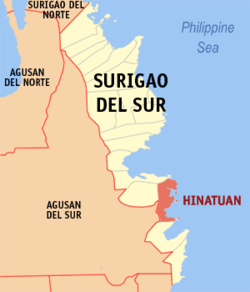Hinatuan, Surigao del Sur
| Hinatuan | ||
|---|---|---|
| Municipality | ||
| ||
 Map of Surigao del Sur with Hinatuan highlighted | ||
.svg.png) Hinatuan Location within the Philippines | ||
| Coordinates: 08°22′N 126°20′E / 8.367°N 126.333°ECoordinates: 08°22′N 126°20′E / 8.367°N 126.333°E | ||
| Country | Philippines | |
| Region | Caraga (Region XIII) | |
| Province | Surigao del Sur | |
| District | 2nd district of Surigao del Sur | |
| Barangays | 24 | |
| Government[1] | ||
| • Mayor | Candelario J. Viola, Jr. | |
| Area[2] | ||
| • Total | 299.10 km2 (115.48 sq mi) | |
| Population (2010)[3] | ||
| • Total | 38,731 | |
| • Density | 130/km2 (340/sq mi) | |
| Time zone | PST (UTC+8) | |
| ZIP code | 8310 | |
| Dialing code | 86 | |
| Income class | 2nd | |
| Languages | Kamayo, Mindanao Cebuano, Filipino, English | |
Hinatuan is a second class municipality in the province of Surigao del Sur, Philippines. According to the 2010 census, it has a population of 38,731 people.[3]
Barangays

Pepsi-blue waters of the world-renowned underground river in Brgy. Talisay, Hinatuan popularly called as the "Hinatuan Enchanted River" is a known attraction among tourists both locally and internationally
Hinatuan is politically subdivided into 24 barangays.[2]
- Baculin
- Bigaan
- Cambatong
- Campa
- Dugmanon
- Harip
- La Casa (Pob.)
- Loyola
- Maligaya
- Pagtigui-an (Bitoon)
- Pocto
- Port Lamon
- Roxas
- San Juan
- Sasa
- Tagasaka
- Tagbobonga
- Talisay
- Tarusan
- Tidman
- Tiwi
- Zone I Benigno Aquino (Pob.)
- Zone II Sto. Niño (Pob.)
- Zone III Maharlika (Pob.)
Demographics
| Population census of Hinatuan | ||
|---|---|---|
| Year | Pop. | ±% p.a. |
| 1990 | 33,307 | — |
| 1995 | 34,602 | +0.72% |
| 2000 | 36,170 | +0.95% |
| 2007 | 37,368 | +0.45% |
| 2010 | 38,731 | +1.31% |
| Source: National Statistics Office[3] | ||
References
- ↑ "Official City/Municipal 2013 Election Results". Intramuros, Manila, Philippines: Commission on Elections (COMELEC). 1 July 2013. Retrieved 5 September 2013.
- 1 2 "Province: SURIGAO DEL SUR". PSGC Interactive. Makati City, Philippines: National Statistical Coordination Board. Retrieved 1 April 2014.
- 1 2 3 "Total Population by Province, City, Municipality and Barangay: as of May 1, 2010" (PDF). 2010 Census of Population and Housing. National Statistics Office. Retrieved 1 April 2014.
External links
- Philippine Standard Geographic Code
- Philippine Census Information
- Local Governance Performance Management System
 |
Barobo |  | ||
| Tagbina Rosario, Agusan del Sur |
|
Philippine Sea | ||
| ||||
| | ||||
| Bislig |
| ||||||||||||||
This article is issued from Wikipedia - version of the Sunday, February 14, 2016. The text is available under the Creative Commons Attribution/Share Alike but additional terms may apply for the media files.
